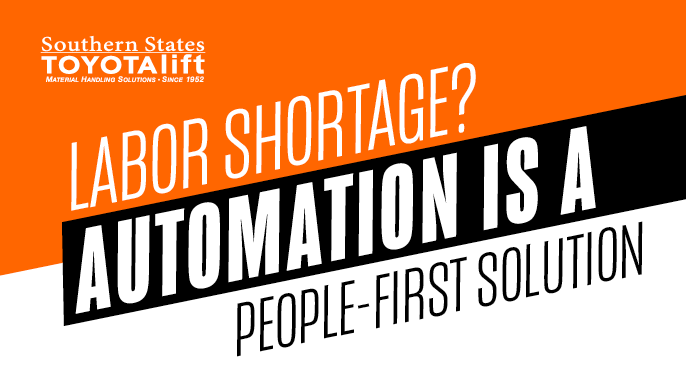Labor Shortage Problem? Why Automation is a People-First Solution
by Brian Reaves, on Feb 26, 2024 9:30:26 PM

Hiring and retaining qualified workers is one of the top challenges manufacturing and supply chain leaders face. Yet fewer than 20% of operations in the U.S. use some form of automation.
So why aren’t more companies using automation to fill the labor gap?
After speaking to customers here in Georgia and Florida, we find there are two misconceptions that hold companies back:
- Adding robots inevitably leads to firing good people
- Automation costs a lot to implement
No company wants to be known as the place that replaced humans with robots. But that’s not how automation works. It allows people to take on more interesting and fulfilling work while robots do the repetitive, monotonous tasks. I’ll address the common misconception about cost later in the article.
First, here’s a tale of two operations:
Cutting-Edge vs. On the Edge of Town
Operation #1 Struggles to hire and retain associates at its new facility, which is a 30 minute drive outside of town. The operation pays more than local fast-food chains, but turnover remains high. The long commute and tiresome work cause people to quit after a few weeks. They’d rather work a less strenuous job closer to home — even if it pays a little less.
It’s hard to say who’s more frustrated: the HR department that struggles to recruit qualified workers or the supervisors who feel like they’re constantly training new team members.
Operation #2 Also has a facility on the outskirts of town. Unlike Operation #1, robots handle the mundane and strenuous work. The robots are multilingual, and associate training takes only a few hours.
Having humans and robots work together has improved accuracy, safety and employee retention. HR regularly receives referrals from associates’ friends and family who’ve heard about their job working with high-tech robots.
Are these examples based on real companies?
The first operation is a composite of actual businesses in Georgia and Florida. The second is based on an eCommerce and returns processing facility in the UK that ships 15 million items per year.
Will automation replace the need for workers?
No. Automation is meant to support your existing crew, not replace them. Whether you use picker robots, autonomous carts to shuttle heavy cargo around, or even a basic conveyor system, technology eliminates the boring and strenuous parts of work, not jobs.
Instead of doing repetitive or physically exhausting tasks, your associates can focus on things that require problem-solving and creativity — something only humans can do. People worry automation will replace workers and take away warehouse jobs and that’s understandable. But the truth is: that automation makes warehouse and manufacturing jobs more interesting and fulfilling.
The Labor Shortage Is Likely a Long-Term Problem
According to stats from the BLS (Bureau of Labor Statistics) reported in Supply Chain Quarterly:
- Turnover rates in manufacturing reached nearly 40%
- Warehouse turnover rates hit 49%
The survey also revealed, “Only 3.5% of Generation Z respondents expressed an interest in working in manufacturing and only 2.9% expressed an interest in transportation, distribution, and logistics.” Unless these jobs evolve, it’s unlikely we’ll see a rebound in the labor pool.
Automation is a people-first solution.
- It can help you recruit top talent because your company is perceived as an innovator.
- The work is more rewarding. Robots run products back and forth while people do more complex, value-added tasks.
- Injuries are reduced and accuracy improves, which boosts customer and employee satisfaction.
Automation is More Affordable Than You May Realize
Now it’s time to address misconception number two: automation costs too much. You may be surprised to learn: the order picking robots featured in the video above are subscription-based.
- Upfront costs are very low
- You can start with just a few robots
- And add or remove robots at any time
Other automation solutions also deliver a rapid return on investment. A simple pick-to-light system instantly improves both productivity and accuracy — which reduces costs.
Automation provides another cost-saving benefit many people overlook: robots, automated vehicles, sorters and ASRS (storage and retrieval systems) are always available to work an extra shift. You can adjust to seasonal demand spikes without blowing your budget on overtime and holiday pay. Not to mention, you’ll save time recruiting and training seasonal staff.
If your business competes with operations overseas, here’s an important data point to consider. Earlier, I mentioned only 20% of operations in the U.S. use some form of automation. It’s worth noting that, worldwide, 38% of companies have adopted automation.
Ready to make your operation more resilient?
Overcoming the labor shortage and future-proofing your business has never been more affordable. SST offers flexible financing, including capital and operating leases with payment terms aligned to your business cycle.
If you’d like to know more, schedule a free, no-pressure consultation. Discuss options with one of our experts or schedule a free site survey. Either way, you’ll be able to make an informed decision about whether order picker robots, automated vehicles, etc. might be right for you. Our goal is to help your business be more successful, not sell you equipment you don’t need.
Contact us online, by phone at (800) 226-2345 or in person at one of our ten locations throughout Georgia and Florida
GEORGIA: Albany, Macon, Midland, Valdosta
FLORIDA: Jacksonville, Ocala, Orlando, Lakeland, Tampa, Winter Haven
Further Reading
The Cost of Not Automating Your Warehouse
How to Improve Warehouse Picking Speed and Accuracy
How Automation Creates Jobs
5 Signs It’s Time to Automate Your Warehouse









